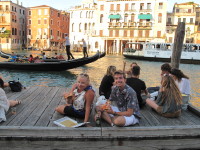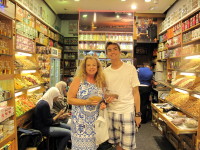This Just In
It is Breakfast Somewhere in the World
For me, one of the most exciting things about travelling is the different foods you can enjoy, and, more specifically, the different breakfasts that you can experience. International hotels will almost always offer a standard meal of toast and cereals, but, if you’re lucky, this will often be served alongside more traditional fare. Here are a few breakfasts from around the world:
Wales- Laverbread and cockles

Laverbread is a type of edible seaweed that can be found on the rocks of the ever nearby coastline in Wales. Cockles are a kind of mollusk and are most often served fried.
Spain- Churros con Chocolate

Churros are a kind of long, thick doughnut that are often served with hot chocolate (for dipping purposes).
Russia- Buckwheat Porridge

This porridge is called “kasha” and is usually made of buckwheat and topped with sour cream
Japan- asa-gohan

The literal translation for “asa gohan” is ‘morning rice’. This platter also consists of the very colourful pickled ume fruits, which are meant to be really good for balancing the digestive system.
Vietnam- Xoi

Xoi is a kind of sweet sticky rice wrapped in banana leaves that is eaten all throughout rural Vietnam for breakfast.
Turkey- A bit of everything!

Breakfast is a real feast in Turkey. This platter features olives, feta and havarti cheese, grape leaf dolmas, tomato, cucumber and hard-boiled egg, side by side withpastries, fresh bread and coffee.
Thanks to (in order of images) Mikey Swales…fish related tales, nette1274, sweetbeatandgreenbean, gbSK, mckaysavage and jhritz
Asia
China
When it comes to the Chinese breakfast, the sheer number of regional variations can be intimidating; but regardless of where you are, the steamer is an essential tool. For chawanmushi, eggs are beaten with chicken broth, soy, and sake then steamed until silky, while buns are filled with barbecued pork before hitting the steamer. A typical Shanghai breakfast is youtiao, a deep-fried doughnut shaped like a hot dog; Taiwanese fritters and sesame-seed cakes come wrapped in paper and are to be eaten with your fingers. Dim sum, a hallmark of Cantonese cuisine, always includes shu mai dumplings. It’s considered more “modern” to eat congee with a ceramic spoon rather than slurped from a bowl; one of the most unusual condiments for this rice porridge is “century eggs” that have been “cooked” in an alkaline mix of clay, ash, lime, and salt.
Japan
The classic bento box meal includes miso soup, grilled fish, a rolled omelette, rice, Japanese pickles, and green tea. You may scoop squares of tofu with a metal utensil that looks like a miniature gardening tool, and sheets of nori (seaweed) stay crisp in sheer tissue packaging.
Korea
The palate-awakening sensation of kimchi starts early, when it’s served alongside porridge with shredded chicken or various soups made with dried pollack, beef ribs, or seaweed.
Vietnam
The centerpiece here is pho, the fragrant (and nearly impossible to pronounce) noodle soup with star anise, cinnamon, cardamom, and basil. A spicier variation is bun bo hue, with lemongrass, banana blossoms, shrimp paste, and—wait for it—chiles. Locals also favor banh mi sandwiches: baguettes filled with various meats, meatballs, and pâtés. Vietnamese coffee is high-octane, mixed with sweetened condensed milk and often poured over ice.
Thailand
Rice noodles (flatter and wider than those in pad thai) appear with mouth-tingling condiments such as fresh or preserved chiles in vinegar. In Bangkok, jasmine rice is boiled as khao tom or fried as khao pat, with shrimp, pork, or chicken.
Indonesia and Malaysia
The morning meal in Bali, Jakarta, and Kuala Lumpur reflects the hegemony of rice. Variations include nasi goreng (fried rice with prawns, chicken, and egg), nasi lemak (coconut-infused rice with crisp anchovies), and bubur ayam (rice porridge with chicken, egg, and shallots). For the sweet tooth there’s pisang goreng (banana fritters with palm sugar).
Singapore
Another soup-for-breakfast culture, with offerings that include floating fish balls or wontons. Tau suan (mung-bean soup) topped with slices of fried dough is a morning dessert. Toast is slathered with kaya, a coconut-egg jam that may be shockingly green from the addition of vanilla-scented pandan leaves.
India
Traditional South Indian breakfast means masala dosa (lacy crêpes filled with spiced potato and turmeric), idli (steamed lentil dumplings), and sambar, a tamarind-scented vegetarian soup. In Mumbai, you’ll find pohe (beaten rice flakes with aromatic spices); in Goa, egg curry; and in Rajasthan, puffy kachoris stuffed with beans or lentils, then fried in hot oil and served with assorted chutneys such as mint or coriander. The legendary breads of India include fluffy puris, flaky parathas, and soft buns called pao bhaji, served with a vegetable curry. The drink of choice is yogurt lassi, either sweet or salted.
Europe
Great Britain and Ireland
If you’re feeling adventurous, the British Isles may be the ticket. Irish black pudding is made of curdled and boiled pig’s blood, mixed with chunks of pork fat and stuffed into a sausage casing. The Scots have an equally formidable tradition: haggis—sheep’s liver, heart, and lungs mixed with oatmeal and suet, then simmered in the sheep’s intestines. Tamer palates might prefer the classic English breakfast, with eggs, bangers (sausages) or streaky bacon, tomatoes, and mushrooms. It’s often called a fry-up for good reason: just about everything on the plate is fried, including the toast. The Brits may add baked beans or bubble and squeak (potatoes mashed with cabbage).
Scandinavia
Filmjölk tastes something like a peace accord between sour cream and buttermilk, but it’s eaten like yogurt, in a bowl with cereal. The champion of the Nordic bread basket is knäckebröd, or crispbread, and Swedes start the day with fish roe (smoked or not), made into a spreadable paste with mashed potatoes, according to a centuries-old recipe (also sold in tubes by IKEA stores all over the world).
Central Europe
The Czech “Bohemian” breakfast (similar to those in Austria and Hungary) may include cold cuts, terrines, and hermelin, a soft cheese sometimes pickled with oil and herbs. If you’re lucky, you’ll find palacinka, the local version of crêpes.
Southern Europe
Aside from the requisite caffè, an Italian breakfast spread might include cured meats (Parma ham; mortadella from Bologna) and cheeses (pecorino in Rome; smoked scamorza in Puglia). In Spain, potatoes, onions, and eggs are cooked in olive oil and formed into a fat, round tortilla española, from which slices are cut all day long. The slightly more decadent Spanish breakfast is deep-fried churros dunked in bittersweet hot chocolate. In Greece, one look at the contented sheep and goats grazing on any mountain tells you there will be great feta. Breakfast pies are made with phyllo dough and cheese and spinach or wild greens.
My Favorite
Russia
The morning porridge has kasha (buckwheat groats) as its base. But that’s breakfast for the hoi polloi. To eat like the czars, choose syrniki (fried cheese pancakes) with sour cream and honey or blini with red caviar.
Africa and the Middle East
Egypt
This cradle of civilization can also lay claim to one of the most popular dishes of the region: ful medames, slow-cooked fava beans mashed with olive oil, parsley, garlic, and lemon juice. Here, it’s mopped up with Arabic breads similar to pitas. The local rendition of cream of wheat is belila, served hot or cold and sprinkled with shredded coconut.
Israel
In Israel, the lavish morning buffet (salads; fresh fruit and vegetables; cheese; smoked fish; baba ghanoush) dates from the beginnings of the kibbutz, when workers fueled up for the day ahead. The popular shakshuka (eggs poached in spicy tomato sauce) was introduced by Tunisian immigrants.
Lebanon
As with the rest of the Middle East, the morning meal centers around spreads such as hummus or baba ghanoush with pita bread, the thick yogurt called labneh, and salads of peppers or cucumbers. Here, you’ll also find the pizza-like manakish (baked dough topped with spices, meats, or cheese) and eggs with awarma (minced meat).
United Arab Emirates
An Arabian breakfast may include halloumi cheese, with a flat bread called saj that is twirled like a pizza, shaped on a round pillow, and baked on a domed metal griddle. Don’t expect a western omelette: the local favorite is filled with fresh coriander and marinated olives.
Morocco
You may eat laasida, a thick porridge made with barley meal and served with butter and honey, or a square layered bread called msemmen with amlou, a dip of toasted almonds, argan oil, and honey.
Southern and Eastern Africa
Mandazi are the doughnuts of Tanzania and Kenya, usually hole-less, sometimes with ground nuts added to the dough, and served with locally grown coffee or chai; chapatis are similar to warm flour tortillas. A tooth-achingly sweet pastry native to Cape Town, South Africa, is koeksister (like a doughnut dipped in syrup), eaten with extra-strong moer koffie or rooibos tea, which is naturally caffeine-free and grown only in South Africa. Variations on cornmeal mush are called ugali in the east and mealies in the south. Franschhoek salmon, from the waters off the Western Cape province, is smoked and served with eggs.
The Americas
United States
Grits! Biscuits! Redeye gravy! These, of course, are the staples of a Southern breakfast. Plus, andouille sausage, pain perdu (French toast to you), and beignets (gilded, if you wish, with praline dipping sauce) in New Orleans. Peppers are in everything in the Southwest, while the region’s pancakes are made with blue-corn flour and sweetened with agave syrup. New England is all about maple syrup, perhaps poured over hotcakes made with Maine’s wild blueberries. And in the Pacific Northwest there’s salmon, smoked and made into hash. Loco moco is Hawaii’s decadent fast-food answer to the Egg McMuffin: white rice with a hamburger patty, a fried egg, and gravy.
Caribbean
Puerto Rico’s yeasty egg bread, pan de mallorca (from the Spanish island of the same name), accompanies café con leche. In Jamaica, ackee with saltfish looks like scrambled eggs, but ackee is a fruit; callaloo, served on the side, is a leafy green. The dish often comes with bami (cassava flatbread), johnnycakes (fried dumplings), breadfruit, and Jamaica’s famous Blue Mountain coffee.
Mexico
Huitlacoche, a fungus considered a delicacy, is stirred into omelettes. But the breakfast Mexican mothers make to use up day-old corn tortillas is chilaquiles: the stale bits are fried in oil, then mixed with salsa, eggs, and a side of beans or nopalitos (the paddles of the prickly pear cactus).
Brazil
Along with the country’s famous coffee, most hotels offer a basket of small round pão de queijo (cheese breads made with tapioca flour) that are surprisingly addictive despite having the consistency of chewing gum.
Costa Rica and Nicaragua
The national breakfast dish of these two nations is gallo pinto (painted rooster), a reference to the speckled appearance of the mixed beans and rice, but also an attempt to conceal the fact that it’s frugally meatless. A more luxurious version would be served with stewed meat and chorreadas, Costa Rican corn pancakes.
Peru
Sweet rolls called chancays (named for a small port town) are anise-flavored and often served with Paria cheese from the Andes. Jams are made with elderberries or gooseberries, and pancakes are quinoa-based, with a hint of oporto (port wine).
Argentina
Don’t expect eggs; they’re not served before lunch. Instead, order colaciones pastries filled with dulce de leche or fruit, and yerba maté, an herbal beverage with antioxidant properties that’s made by steeping the leaves of a South American tree. Hotels, however, may not serve it in the traditional way: from a shared hollow gourd with a metal straw.
Aimee Lee Ball is the co-author of four books and writes frequently for the New York Times. This is a great article
Copyright © 2025. All Rights Reserved.
Penny Fleming (949) 631-5596Award & Promotional Product Designer
Creating Events and Promotions Since 1983
Website design and development by PRomoting Webs







